Gelatin-Polyvinyl Alcohol Film for Tissue Engineering: A Concise Review
Abstract
:1. Introduction
1.1. Tissue Engineering
1.2. Composite/Hybrid Biomaterials
1.3. Film Applications and Its Advantage
1.4. Biomaterials for the Film
2. Literature Search and Data Extraction Management
3. Fabrication of Gelatin-PVA Film
4. Gelatin-PVA Film Characterisation
4.1. Fourier Transform Infrared (FTIR) Analysis
4.2. Mechanical Properties
4.3. Thermal Properties
4.4. Swelling Study
4.5. Differential Scanning Calorimetry and UV-vis Analysis
4.6. Molecular Structure
4.7. Crosslinking Degree and Surface Hydrophilicity
4.8. In Vitro Biocompatibility and Cytotoxicity
5. Discussion for Each Characterisation Parameters
5.1. Fabrication of Gelatin-PVA Film by Film Casting Method
5.2. Characterisation of the Film
6. Challenges and Limitations of Gelatin-PVA Film for Commercial Applications
7. Conclusions and Future Perspectives
Author Contributions
Funding
Institutional Review Board Statement
Informed Consent Statement
Data Availability Statement
Acknowledgments
Conflicts of Interest
References
- Chen, F.-M.; Liu, X. Advancing biomaterials of human origin for tissue engineering. Prog. Polym. Sci. 2016, 53, 86–168. [Google Scholar] [CrossRef] [Green Version]
- Mh Busra, F.; Rajab, N.F.; Tabata, Y.; Saim, A.B.; BH Idrus, R.; Chowdhury, S.R. Rapid treatment of full-thickness skin loss using ovine tendon collagen type I scaffold with skin cells. J. Tissue Eng. Regen. Med. 2019, 13, 874–891. [Google Scholar] [CrossRef]
- Bambole, V.; Yakhmi, J.V. Tissue engineering: Use of electrospinning technique for recreating physiological functions. In Nanobiomaterials in Soft Tissue Engineering; Elsevier: Amsterdam, The Netherlands, 2016; pp. 387–455. [Google Scholar]
- Mannella, G.A.; Pavia, F.C.; La Carrubba, V.; Brucato, V. Phase separation of polymer blends in solution: A case study. Eur. Polym. J. 2016, 79, 176–186. [Google Scholar] [CrossRef]
- Utracki, L.A.; Wilkie, C.A. Polymer Blends Handbook; Springer: Dordrecht, The Netherlands, 2002. [Google Scholar]
- Busra, M.F.M.; Lokanathan, Y. Recent development in the fabrication of collagen scaffolds for tissue engineering applications: A review. Curr. Pharm. Biotechnol. 2019, 20, 992–1003. [Google Scholar] [CrossRef] [PubMed]
- Santos, E.; Orive, G.; Hernández, R.M.; Pedraz, J.L. Cell-biomaterial interaction: Strategies to mimic the extracellular matrix. In On Biomimetics; Intech China: Shanghai, China, 2011. [Google Scholar]
- Raspa, A.; Gelain, F. Mimicking extracellular matrix via engineered nanostructured biomaterials for neural repair. Curr. Neuropharmacol. 2020. [Google Scholar] [CrossRef]
- Bello, A.B.; Kim, D.; Kim, D.; Park, H.; Lee, S.-H. Engineering and functionalization of gelatin biomaterials: From cell culture to medical applications. Tissue Eng. Part B Rev. 2020, 26, 164–180. [Google Scholar] [CrossRef] [PubMed] [Green Version]
- De Santis, R.; Guarino, V.; Ambrosio, L. Composite biomaterials for bone repair. In Bone Repair Biomaterials; Elsevier: Amsterdam, The Netherlands, 2019; pp. 273–299. [Google Scholar]
- Jayakumar, R.; Prabaharan, M.; Kumar, P.S.; Nair, S.; Tamura, H. Biomaterials based on chitin and chitosan in wound dressing applications. Biotechnol. Adv. 2011, 29, 322–337. [Google Scholar] [CrossRef] [PubMed]
- Pereira, R.F.; Bartolo, P.J. Traditional therapies for skin wound healing. Adv. Wound Care 2016, 5, 208–229. [Google Scholar] [CrossRef] [Green Version]
- Dissemond, J.; Augustin, M.; Eming, S.A.; Goerge, T.; Horn, T.; Karrer, S.; Schumann, H.; Stücker, M.; For the working group for wound healing (AGW) of the German Society of Dermatology (DDG). Modern wound care–practical aspects of non-interventional topical treatment of patients with chronic wounds. JDDG J. Dtsch. Dermatol. Ges. 2014, 12, 541–554. [Google Scholar] [CrossRef]
- Abrigo, M.; McArthur, S.L.; Kingshott, P. Electrospun nanofibers as dressings for chronic wound care: Advances, challenges, and future prospects. Macromol. Biosci. 2014, 14, 772–792. [Google Scholar] [CrossRef]
- Negut, I.; Dorcioman, G.; Grumezescu, V. Scaffolds for Wound Healing Applications. Polymers 2020, 12, 2010. [Google Scholar] [CrossRef]
- Rowan, M.P.; Cancio, L.C.; Elster, E.A.; Burmeister, D.M.; Rose, L.F.; Natesan, S.; Chan, R.K.; Christy, R.J.; Chung, K.K. Burn wound healing and treatment: Review and advancements. Crit. Care 2015, 19, 1–12. [Google Scholar] [CrossRef] [Green Version]
- Amri, M.; Firdaus, M.; Fauzi, M.; Chowdhury, S.R.; Fadilah, N.; Wan Hamirul, W.; Reusmaazran, M.; Aminuddin, B.; Ruszymah, B. Cytotoxic evaluation of biomechanically improved crosslinked ovine collagen on human dermal fibroblasts. Bio-Med. Mater. Eng. 2014, 24, 1715–1724. [Google Scholar] [CrossRef]
- Fauzi, M.; Lokanathan, Y.; Aminuddin, B.; Ruszymah, B.; Chowdhury, S. Ovine tendon collagen: Extraction, characterisation and fabrication of thin films for tissue engineering applications. Mater. Sci. Eng. C 2016, 68, 163–171. [Google Scholar] [CrossRef]
- Anderson, J.M.; Miller, K.M. Biomaterial biocompatibility and the macrophage. Biomaterials 1984, 5, 5–10. [Google Scholar] [CrossRef]
- Joyce, K.; Fabra, G.T.; Bozkurt, Y.; Pandit, A. Bioactive potential of natural biomaterials: Identification, retention and assessment of biological properties. Signal Transduct. Target. Ther. 2021, 6, 1–28. [Google Scholar]
- Masri, S.; Fauzi, M.B. Current insight of printability quality improvement strategies in natural-based bioinks for skin regeneration and wound healing. Polymers 2021, 13, 1011. [Google Scholar] [CrossRef]
- Bhattacharjee, P.; Ahearne, M. Significance of Crosslinking Approaches in the Development of Next Generation Hydrogels for Corneal Tissue Engineering. Pharmaceutics 2021, 13, 319. [Google Scholar] [CrossRef] [PubMed]
- Reddy, N.; Reddy, R.; Jiang, Q. Crosslinking biopolymers for biomedical applications. Trends Biotechnol. 2015, 33, 362–369. [Google Scholar] [CrossRef] [PubMed]
- Lutolf, M.; Hubbell, J. Synthetic biomaterials as instructive extracellular microenvironments for morphogenesis in tissue engineering. Nat. Biotechnol. 2005, 23, 47–55. [Google Scholar] [CrossRef] [PubMed]
- Subhan, F.; Ikram, M.; Shehzad, A.; Ghafoor, A. Marine collagen: An emerging player in biomedical applications. J. Food Sci. Technol. 2015, 52, 4703–4707. [Google Scholar] [CrossRef] [Green Version]
- Samavedi, S.; Poindexter, L.K.; Van Dyke, M.; Goldstein, A.S. Synthetic biomaterials for regenerative medicine applications. In Regenerative Medicine Applications in Organ Transplantation; Elsevier: Amsterdam, The Netherlands, 2014; pp. 81–99. [Google Scholar]
- Mohiti-Asli, M.; Loboa, E. Nanofibrous smart bandages for wound care. Wound Heal. Biomater. 2016, 483–499. [Google Scholar] [CrossRef]
- Deshmukh, K.; Ahamed, M.B.; Deshmukh, R.; Pasha, S.K.; Bhagat, P.; Chidambaram, K. Biopolymer composites with high dielectric performance: Interface engineering. In Biopolymer Composites in Electronics; Elsevier: Amsterdam, The Netherlands, 2017; pp. 27–128. [Google Scholar]
- Alihosseini, F. Plant-based compounds for antimicrobial textiles. In Antimicrobial Textiles; Elsevier: Amsterdam, The Netherlands, 2016; pp. 155–195. [Google Scholar]
- Reis, R.L. Encyclopedia of Tissue Engineering and Regenerative Medicine; Academic Press: Cambridge, MA, USA, 2019. [Google Scholar]
- Davidenko, N.; Schuster, C.F.; Bax, D.V.; Farndale, R.W.; Hamaia, S.; Best, S.M.; Cameron, R.E. Evaluation of cell binding to collagen and gelatin: A study of the effect of 2D and 3D architecture and surface chemistry. J. Mater. Sci. Mater. Med. 2016, 27, 1–14. [Google Scholar] [CrossRef] [PubMed] [Green Version]
- Djagny, K.B.; Wang, Z.; Xu, S. Gelatin: A valuable protein for food and pharmaceutical industries. Crit. Rev. Food Sci. Nutr. 2001, 41, 481–492. [Google Scholar] [CrossRef]
- Young, S.; Wong, M.; Tabata, Y.; Mikos, A.G. Gelatin as a delivery vehicle for the controlled release of bioactive molecules. J. Control. Release 2005, 109, 256–274. [Google Scholar] [CrossRef] [PubMed]
- Zhang, W.J.; Liu, W.; Cui, L.; Cao, Y. Tissue engineering of blood vessel. J. Cell. Mol. Med. 2007, 11, 945–957. [Google Scholar] [CrossRef]
- Heydarkhan-Hagvall, S.; Schenke-Layland, K.; Dhanasopon, A.P.; Rofail, F.; Smith, H.; Wu, B.M.; Shemin, R.; Beygui, R.E.; MacLellan, W.R. Three-dimensional electrospun ECM-based hybrid scaffolds for cardiovascular tissue engineering. Biomaterials 2008, 29, 2907–2914. [Google Scholar] [CrossRef] [PubMed] [Green Version]
- Zhang, Y.; Ouyang, H.; Lim, C.T.; Ramakrishna, S.; Huang, Z.M. Electrospinning of gelatin fibers and gelatin/PCL composite fibrous scaffolds. J. Biomed. Mater. Res. Part B Appl. Biomater. Off. J. Soc. Biomater. Jpn. Soc. Biomater. Aust. Soc. Biomater. Korean Soc. Biomater. 2005, 72, 156–165. [Google Scholar] [CrossRef]
- Barnes, C.P.; Sell, S.A.; Boland, E.D.; Simpson, D.G.; Bowlin, G.L. Nanofiber technology: Designing the next generation of tissue engineering scaffolds. Adv. Drug Deliv. Rev. 2007, 59, 1413–1433. [Google Scholar] [CrossRef]
- Reddy, P.R.; Varaprasad, K.; Sadiku, R.; Ramam, K.; Reddy, G.V.S.; Raju, K.M.; Reddy, N.S. Development of gelatin based inorganic nanocomposite hydrogels for inactivation of bacteria. J. Inorg. Organomet. Polym. Mater. 2013, 23, 1054–1060. [Google Scholar] [CrossRef]
- Smandri, A.; Nordin, A.; Hwei, N.M.; Chin, K.-Y.; Abd Aziz, I.; Fauzi, M.B. Natural 3D-Printed Bioinks for Skin Regeneration and Wound Healing: A Systematic Review. Polymers 2020, 12, 1782. [Google Scholar] [CrossRef]
- Qiao, C.; Ma, X.; Zhang, J.; Yao, J. Molecular interactions in gelatin/chitosan composite films. Food Chem. 2017, 235, 45–50. [Google Scholar] [CrossRef]
- Qiu, K.; Netravali, A.N. A composting study of membrane-like polyvinyl alcohol based resins and nanocomposites. J. Polym. Environ. 2013, 21, 658–674. [Google Scholar] [CrossRef]
- Azahari, N.; Othman, N.; Ismail, H. Biodegradation studies of polyvinyl alcohol/corn starch blend films in solid and solution media. J. Phys. Sci. 2011, 22, 15–31. [Google Scholar]
- Barui, A. Synthetic polymeric gel. In Polymeric Gels; Elsevier: Amsterdam, The Netherlands, 2018; pp. 55–90. [Google Scholar]
- Limpan, N.; Prodpran, T.; Benjakul, S.; Prasarpran, S. Influences of degree of hydrolysis and molecular weight of poly (vinyl alcohol)(PVA) on properties of fish myofibrillar protein/PVA blend films. Food Hydrocoll. 2012, 29, 226–233. [Google Scholar] [CrossRef]
- Singh, S.; Gaikwad, K.K.; Lee, Y.S. Antimicrobial and antioxidant properties of polyvinyl alcohol bio composite films containing seaweed extracted cellulose nano-crystal and basil leaves extract. Int. J. Biol. Macromol. 2018, 107, 1879–1887. [Google Scholar] [CrossRef] [PubMed]
- Kannat, S.; Jethwa, T.; Sawant, K.; Chawla, S. PVA-Gelatin films incorporated with tomato pulp: A potential primary food packaging film. Int. J. Curr. Microbiol. Appl. Sci. 2017, 6, 1–14. [Google Scholar]
- Meshram, J.; Koli, V.; Phadatare, M.R.; Pawar, S. Anti-microbial surfaces: An approach for deposition of ZnO nanoparticles on PVA-Gelatin composite film by screen printing technique. Mater. Sci. Eng. C 2017, 73, 257–266. [Google Scholar] [CrossRef]
- Haghighi, H.; Gullo, M.; La China, S.; Pfeifer, F.; Siesler, H.W.; Licciardello, F.; Pulvirenti, A. Characterization of bio-nanocomposite films based on gelatin/polyvinyl alcohol blend reinforced with bacterial cellulose nanowhiskers for food packaging applications. Food Hydrocoll. 2021, 113, 106454. [Google Scholar] [CrossRef]
- Lian, R.; Cao, J.; Jiang, X.; Rogachev, A.V. Prolonged release of ciprofloxacin hydrochloride from chitosan/gelatin/poly (vinyl alcohol) composite films. Mater. Today Commun. 2021, 27, 102219. [Google Scholar] [CrossRef]
- Chaibi, S.; Benachour, D.; Merbah, M.; Cagiao, M.E.; Calleja, F.J.B. The role of crosslinking on the physical properties of gelatin based films. Colloid Polym. Sci. 2015, 293, 2741–2752. [Google Scholar] [CrossRef] [Green Version]
- Ismaiel, A.M.; Salman, H.M.A.; Said, H.M.; Abd El-Sadek, M.S. Synthesis and characterization of biodegradable polyvinyl alcohol/gelatin polymer blend film based on gamma radiation. Indo Am. J. Pharm. Sci. 2018, 5, 3345–3352. [Google Scholar] [CrossRef]
- Al-Mamun, A.; Haque, P.; Debnath, T.; Rahman, M.F.; Islam, J.M.M.; Rahman, M.M.; Khan, M.A. γ-Irradiated gelatin and polyvinyl alcohol films as artificial articular cartilage. J. Thermoplast. Compos. Mater. 2018. [Google Scholar] [CrossRef]
- Basak, P.; Pahari, P.; Das, P.; Das, N.; Samanta, S.K.; Roy, S. Synthesis and Characterisation of Gelatin-PVA/Hydroxyapetite(HAP) Composite for Medical Applications. IOP Conf. Ser. Mater. Sci. Eng. 2018, 410, 012021. [Google Scholar] [CrossRef] [Green Version]
- Jain, D.; Carvalho, E.; Banthia, A.K.; Banerjee, R. Development of polyvinyl alcohol-gelatin membranes for antibiotic delivery in the eye. Drug Dev. Ind. Pharm. 2011, 37, 167–177. [Google Scholar] [CrossRef] [PubMed]
- Ebnalwaled, A.A.; Ismaiel, A.M. Developing novel UV shielding films based on PVA/Gelatin/0.01CuO nanocomposite: On the properties optimization using gamma-irradiation. Measurement 2019, 134, 89–100. [Google Scholar] [CrossRef]
- Khan, M.A.; Rahman, N.; Rahman, M. Preparation and Characterization of Gamma Radiation Cured Gelatin-PVA Bio-blend. Multi-Functional Materials and Structures Iii, Pts 1 and 2. Adv. Mater. Res. 2010, 123–125, 347–350. [Google Scholar] [CrossRef]
- El Bahy, G.S.; El-Sayed, E.S.M.; Mahmoud, A.A.; Gweily, N.M. Preparation and characterization of poly vinyl alcohol/gelatin blends. J. Appl. Sci. Res. 2012, 8, 3544–3551. [Google Scholar]
- El-Kader, F.H.A.; Gafer, S.A.; Basha, A.F.; Bannan, S.I.; Basha, M.A.F. Thermal and Optical Properties of Gelatin/Poly(vinyl alcohol) Blends. J. Appl. Polym. Sci. 2010, 118, 413–420. [Google Scholar] [CrossRef]
- Liu, Z.-J.; Shen, Y. Temperature effect on surface roughening of thin films. Surf. Sci. 2005, 595, 20–29. [Google Scholar] [CrossRef]
- Rowland, C.R.; Lennon, D.P.; Caplan, A.I.; Guilak, F. The effects of crosslinking of scaffolds engineered from cartilage ECM on the chondrogenic differentiation of MSCs. Biomaterials 2013, 34, 5802–5812. [Google Scholar] [CrossRef] [PubMed] [Green Version]
- Oryan, A.; Kamali, A.; Moshiri, A.; Baharvand, H.; Daemi, H. Chemical crosslinking of biopolymeric scaffolds: Current knowledge and future directions of crosslinked engineered bone scaffolds. Int. J. Biol. Macromol. 2018, 107, 678–688. [Google Scholar] [CrossRef]
- Payne, J.W. Polymerization of proteins with glutaraldehyde. Soluble molecular-weight markers. Biochem. J. 1973, 135, 867–873. [Google Scholar] [CrossRef] [Green Version]
- Bakand, S.; Winder, C.; Khalil, C.; Hayes, A. In Vitro Cytotoxicity of Formaldehyde and Glutaraldehyde Mixtures in Human Cells. J. UOEH 2006, 28, 173–178. [Google Scholar]
- Pal, K.; Paulson, A.T.; Rousseau, D. Biopolymers in controlled-release delivery systems. In Modern Biopolymer Science; Elsevier: Amsterdam, The Netherlands, 2009; pp. 519–557. [Google Scholar]
- Linnes, M.P.; Ratner, B.D.; Giachelli, C.M. A fibrinogen-based precision microporous scaffold for tissue engineering. Biomaterials 2007, 28, 5298–5306. [Google Scholar] [CrossRef] [PubMed] [Green Version]
- Gough, J.E.; Scotchford, C.A.; Downes, S. Cytotoxicity of glutaraldehyde crosslinked collagen/poly (vinyl alcohol) films is by the mechanism of apoptosis. J. Biomed. Mater. Res. An. Off. J. Soc. Biomater. Jpn. Soc. Biomater. Aust. Soc. Biomater. Korean Soc. Biomater. 2002, 61, 121–130. [Google Scholar] [CrossRef] [PubMed]
- Sun, H.W.; Feigal, R.; Messer, H. Cytotoxicity of glutaraldehyde and formaldehyde in relation to time of exposure and concentration. Pediatric Dent. 1990, 12, 303–307. [Google Scholar]
- Godwin, A.D. Plasticizers. In Applied Plastics Engineering Handbook; Elsevier: Amsterdam, The Netherlands, 2017; pp. 533–553. [Google Scholar]
- Tamer, T.M.; Sabet, M.M.; Omer, A.M.; Abbas, E.; Eid, A.I.; Mohy-Eldin, M.S.; Hassan, M.A. Hemostatic and antibacterial PVA/Kaolin composite sponges loaded with penicillin–streptomycin for wound dressing applications. Sci. Rep. 2021, 11, 1–15. [Google Scholar] [CrossRef]
- Huang, C.-Y.; Hu, K.-H.; Wei, Z.-H. Comparison of cell behavior on pva/pva-gelatin electrospun nanofibers with random and aligned configuration. Sci. Rep. 2016, 6, 1–8. [Google Scholar] [CrossRef]
- Gaaz, T.S.; Sulong, A.B.; Akhtar, M.N.; Kadhum, A.A.H.; Mohamad, A.B.; Al-Amiery, A.A. Properties and applications of polyvinyl alcohol, halloysite nanotubes and their nanocomposites. Molecules 2015, 20, 22833–22847. [Google Scholar] [CrossRef] [Green Version]
- Charles, J.; Ramkumaar, G.; Azhagiri, S.; Gunasekaran, S. FTIR and thermal studies on nylon-66 and 30% glass fibre reinforced nylon-66. E-J. Chem. 2009, 6, 23–33. [Google Scholar] [CrossRef] [Green Version]
- Sobral, P.J.d.A.; Carvalho, R.A.d.; Moraes, I.C.F.; Bittante, A.M.Q.B.; Monterrey-Quintero, E.S. Phase transitions in biodegradable films based on blends of gelatin and poly (vinyl alcohol). Food Sci. Technol. 2011, 31, 372–379. [Google Scholar] [CrossRef] [Green Version]
- Webb, K.; Hlady, V.; Tresco, P.A. Relative importance of surface wettability and charged functional groups on NIH 3T3 fibroblast attachment, spreading, and cytoskeletal organization. J. Biomed. Mater. Res. Off. J. Soc. Biomater. Jpn. Soc. Biomater. Aust. Soc. Biomater. 1998, 41, 422–430. [Google Scholar] [CrossRef] [Green Version]
- Ferrari, M.; Cirisano, F.; Morán, M.C. Mammalian cell behavior on hydrophobic substrates: Influence of surface properties. Colloids Interfaces 2019, 3, 48. [Google Scholar] [CrossRef] [Green Version]
- Thangprasert, A.; Tansakul, C.; Thuaksubun, N.; Meesane, J. Mimicked hybrid hydrogel based on gelatin/PVA for tissue engineering in subchondral bone interface for osteoarthritis surgery. Mater. Des. 2019, 183, 108113. [Google Scholar] [CrossRef]
- Nouh, S.; Naby, A.A.; El Hussieny, H. Fast neutron irradiation effects in PM-355 nuclear track detector. Appl. Radiat. Isot. 2007, 65, 1173–1178. [Google Scholar] [CrossRef] [PubMed]
- Kumar, V.; Sonkawade, R.; Dhaliwal, A. Gamma irradiation induced chemical and structural modifications in PM-355 polymeric nuclear track detector film. Nucl. Instrum. Methods Phys. Res. Sect. B Beam Interact. Mater. At. 2012, 290, 59–63. [Google Scholar] [CrossRef]
- Seo, K.H.; You, S.J.; Chun, H.J.; Kim, C.; Lee, W.K.; Lim, Y.M.; Nho, Y.C.; Jang, J.W. In vitro and in vivo biocompatibility of γ-ray crosslinked gelatin-poly (vinyl alcohol) hydrogels. Tissue Eng. Regen. Med. 2009, 6, 414–418. [Google Scholar]
- Shamloo, A.; Aghababaie, Z.; Afjoul, H.; Jami, M.; Bidgoli, M.R.; Vossoughi, M.; Ramazani, A.; Kamyabhesari, K. Fabrication and evaluation of chitosan/gelatin/PVA hydrogel incorporating honey for wound healing applications: An in vitro, in vivo study. Int. J. Pharm. 2021, 592, 120068. [Google Scholar] [CrossRef]
- Eltom, A.; Zhong, G.; Muhammad, A. Scaffold techniques and designs in tissue engineering functions and purposes: A review. Adv. Mater. Sci. Eng. 2019, 2019. [Google Scholar] [CrossRef] [Green Version]
- Fan, Q. Fabric chemical testing. In Fabric Testing; Elsevier: Amsterdam, The Netherlands, 2008; pp. 125–147. [Google Scholar]
- Shabani, H.; Mehdizadeh, M.; Mousavi, S.M.; Dezfouli, E.A.; Solgi, T.; Khodaverdi, M.; Rabiei, M.; Rastegar, H.; Alebouyeh, M. Halal authenticity of gelatin using species-specific PCR. Food Chem. 2015, 184, 203–206. [Google Scholar] [CrossRef] [PubMed]
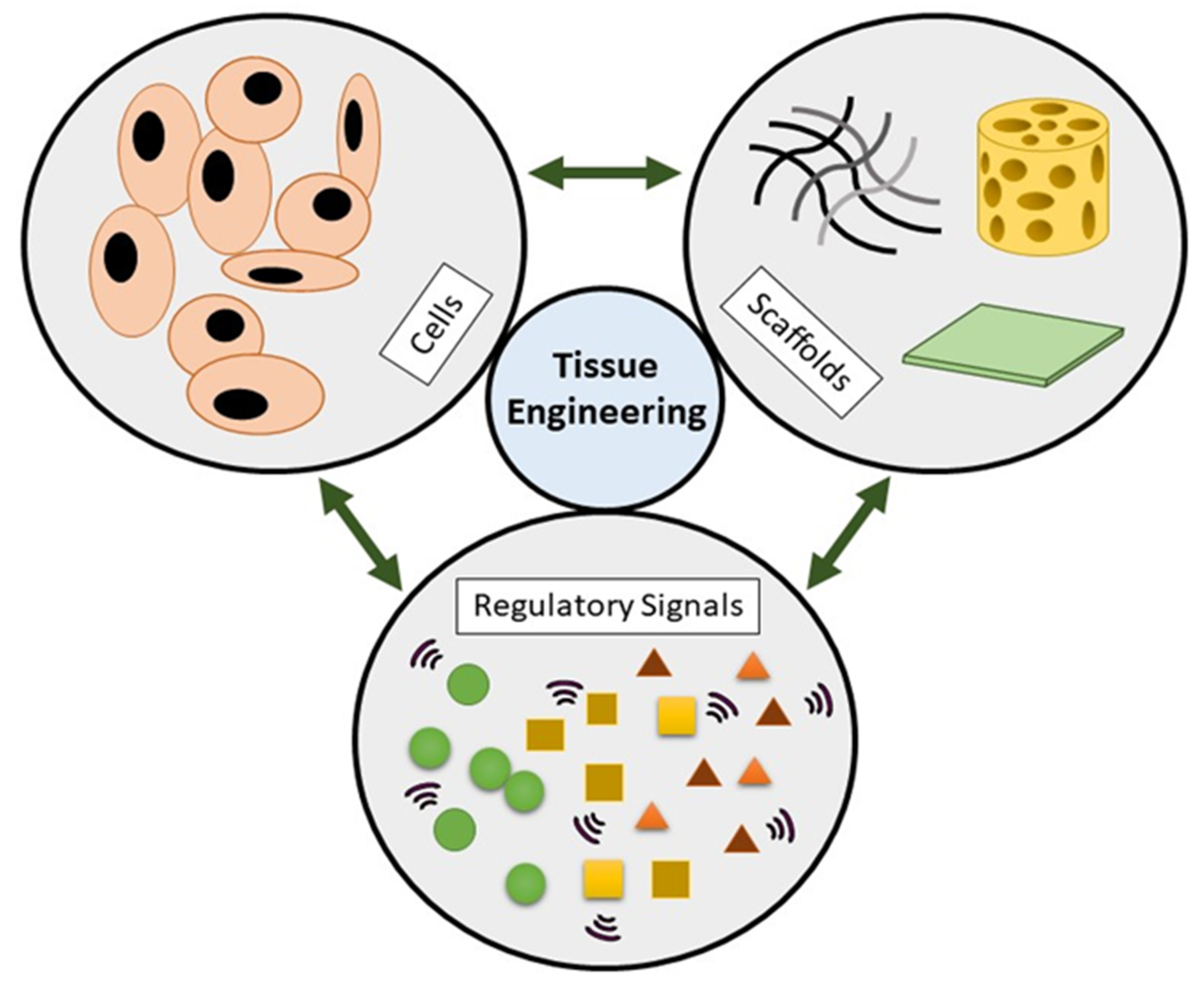

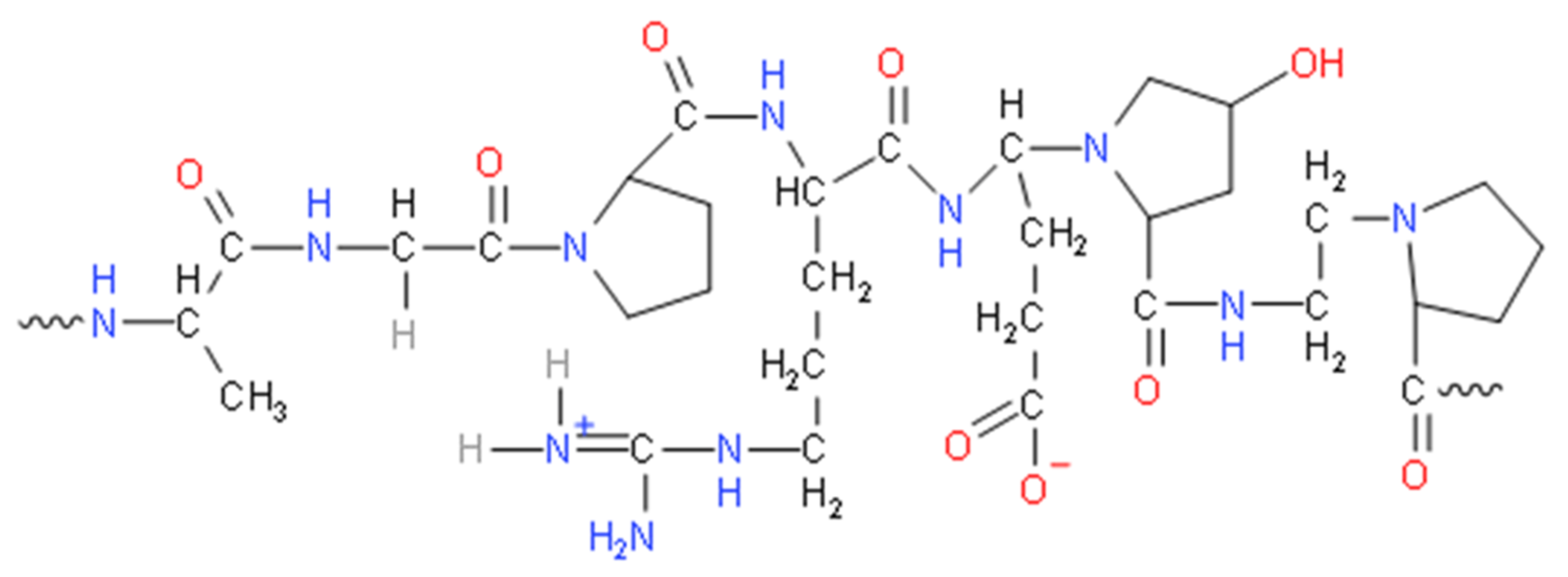



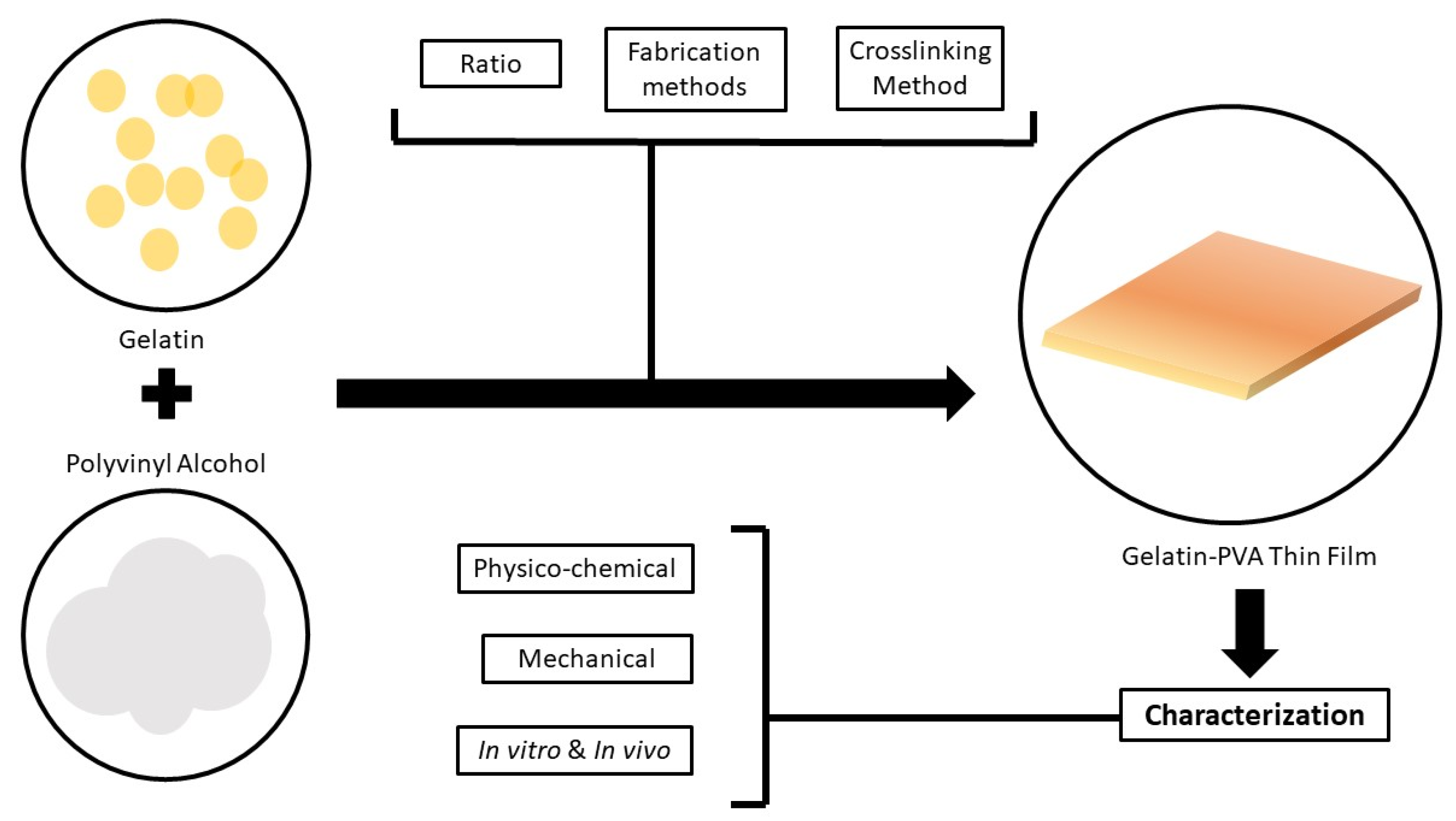
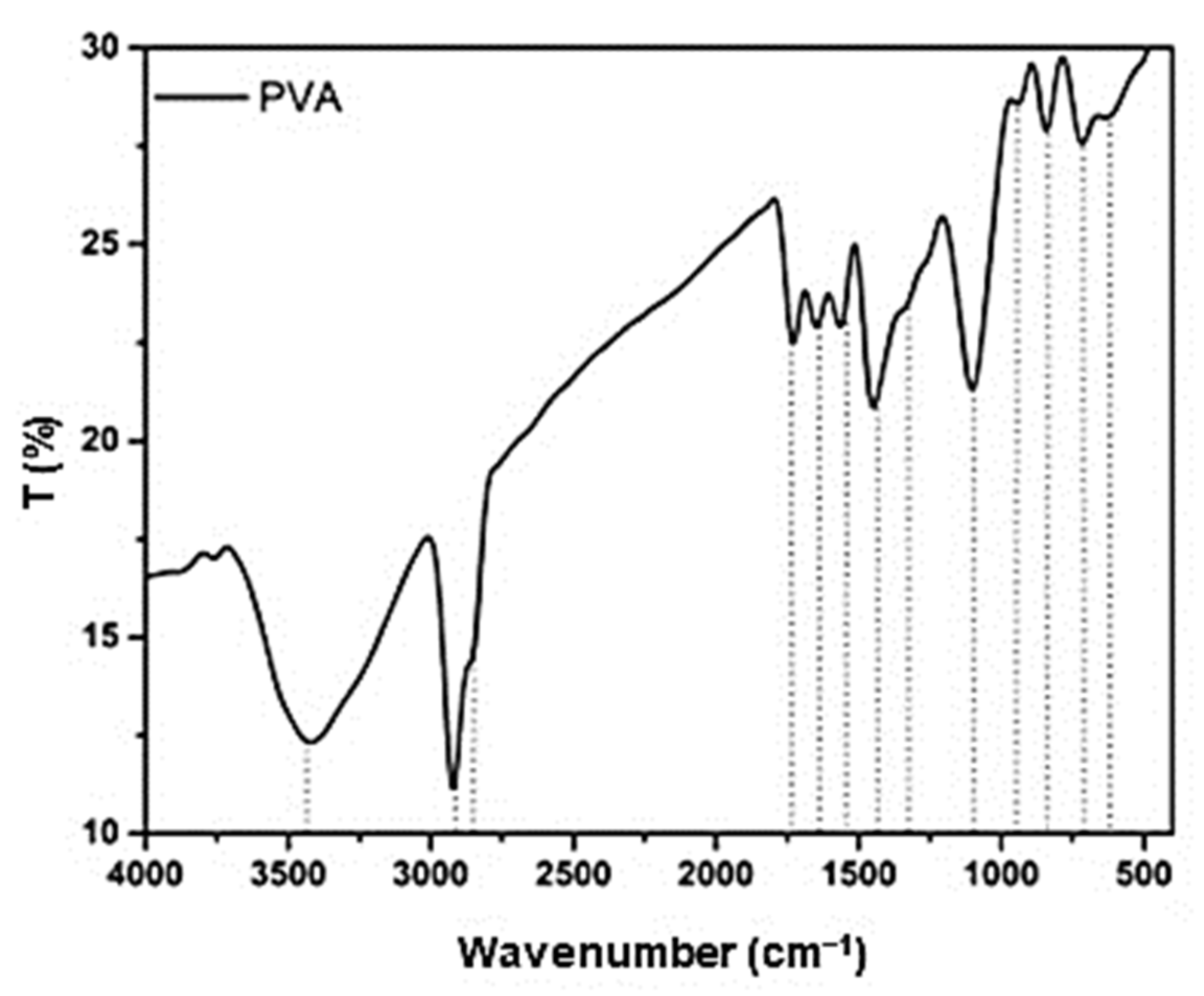
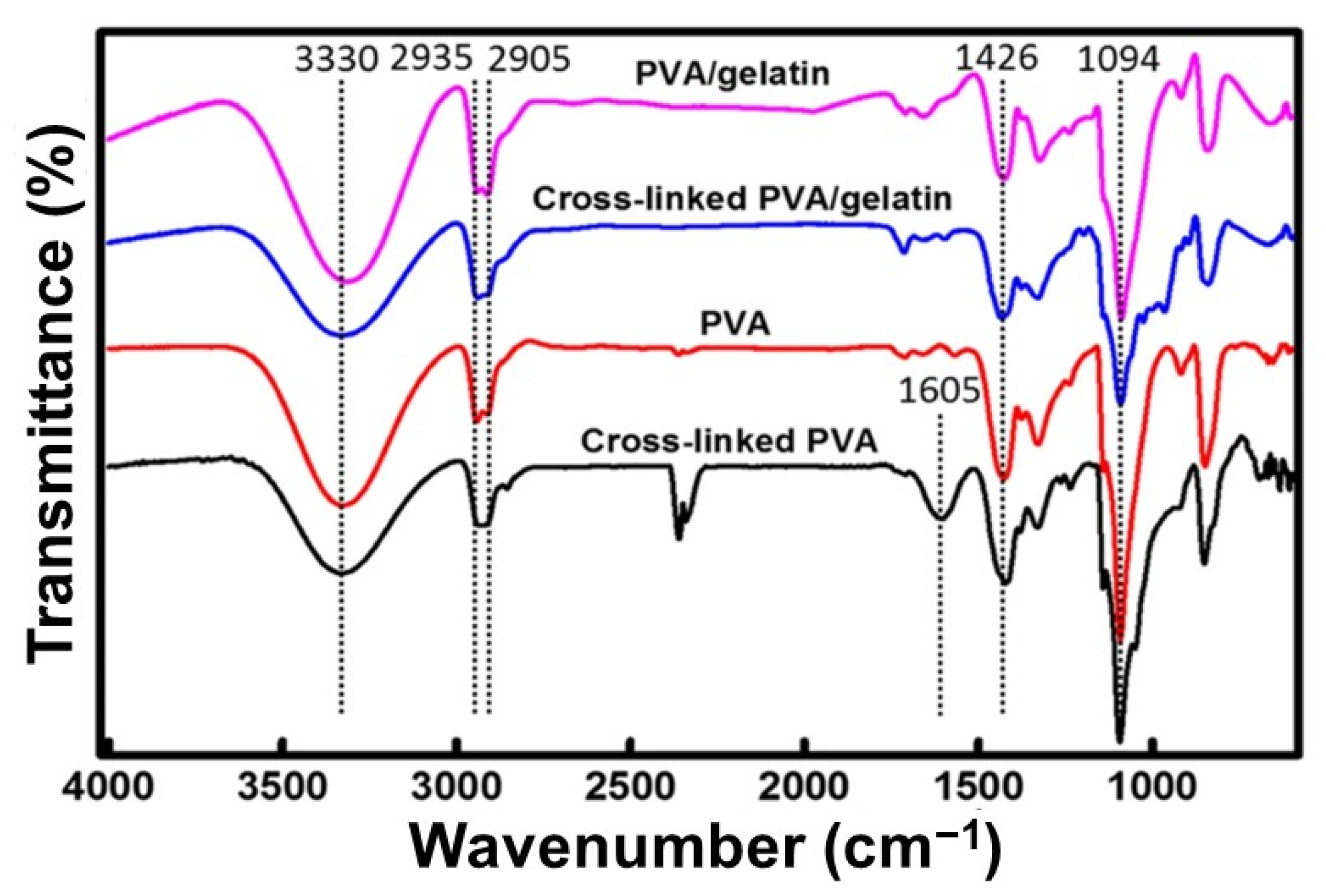

| No | Author | Concentration of Gelatin | Concentration of PVA | Ratio (Gel:PVA) | Crosslinker | Method of Fabrication | Molecular Weight of PVA |
|---|---|---|---|---|---|---|---|
| 1 | Al-Mamun et al. (2020) [52] | 0.11 g/mL | 0.11 g/mL | 1:1 | Gamma-irradiation | Mixed by solution. Blend at pH 2, cast on silicon cloths followed by ambient air drying to form final films. Crosslinked by gamma-irradiation at different dosages for 1 h. | 70,000 g/mol |
| 2 | Ismaiel et al. (2018) [51] | 6 g | 4 g | 1:3 1:1 3:1 | Gamma-irradiation | Mixed by powder into 125 mL of water. Then 0.5 mL citric acid is added and mixed for 90 min before casting into a plexiglass plate. Blends dried at 500 °C in oven for 12 h. The films were then heated in thermosetting oven at 950 °C for 1 h to induce crosslinking reaction. | 450,000 g/mol |
| 3 | Basak et al. (2018) [53] | 5% | 5% | 1:2 | Glutaraldehyde | Film mixed by solution. Added with 200 mg HAP in 10 mL acetic acid. 2% glutaraldehyde added dropwise. Solution then casted at 40 °C for 24 h. | 115,000 kDa |
| 4 | Ebnalwaled et al. (2017) [55] | Not stated | Not stated | 1:1 | Gamma-irradiation | PVA and gelatin powder were added in 125 mL water, stirred at 90 °C for 30 min. Then 0.5 mL of citric acid 0.1 N (plasticiser) was added and mixed. Solution added with copper oxide nanoparticles and mixed at room temperature for 30 min. Homogenised solution casted on glass plate and dried at room temperature. Films were then gamma irradiated at different dose. | 450,000 g/mol |
| 5 | Khan et al. (2010) [56] | Not stated | Not stated | 100:0 95:5 90:10 85:15 | Gamma-irradiation | Mixed by solution at different ratio. Mixed solution is casted onto silicon paper covered glass plate and dried at room temperature for 48 h. Dried films were cut and stored in laminated polythene bag and kept in desiccators in room temperature. Upon testing, films were irradiated under gamma radiation at different doses. | Not stated |
| 6 | El Bahy et al. (2012) [57] | Not stated | Not stated | 1:9 1:4 3:7 2:3 1:1 3:2 7:3 4:1 9:1 | None | Mixed by solution at different ratio. Casted on polyethylene plates and dried at room temperature. Films were then placed in desiccator containing silica gel. | 15,000 g/mol |
| 7 | Jain et al. (2011) [54] | 1, 2, 3% | 10% | 1:10 1:5 3:10 | None | Mixing by solution at different ratios. 500 uL of glycerol (plasticiser) added and mixed together. Esterification between PVA and gelatin initiated by adding 50–100 uL HCl and blend. Ciprofloxacin hydrochloride was added to the blend under magnetic stirring for homogenous dispersion. Casted on Petri plates and dried at room temperature in laminar flow. Dried film rinsed with sodium hydroxide solution. | 125,000 g |
| 8 | El-Kader et al. (2010) [58] | Not stated | Not stated | 1:9 3:7 4:6 1:1 7:3 | None | Mixed by solutions at different ratio at 50 °C. Blends casted onto stainless steel Petri dishes, dried at room temperature for 6 days. | 125, 000 g |
| 9 | Chaibi et al. (2015) [50] | 5 g in 100 mL | 0.2% by weight | 29:43 | Glutaraldehyde | Mixed by solution. 15 mL of blend casted in polystyrene Petri dish. 0.1 mm thickness film obtained. Crosslinked with different concentration of glutaraldehyde via post-crosslinking method. Films soaked in 15 mL of glutaraldehyde for 24 h. | 70,000–100,000 g/mol |
| No | Author | Parameters | Result | Conclusion |
|---|---|---|---|---|
| 1 | Al-Mamun et al. (2020) [52] | FTIR spectroscopy Thermogravimetric analysis DSC analysis Tensile properties Water uptake SEM analysis In vitro cytotoxicity study | FTIR: Higher doses of irradiation shows prominent peaks than lower doses. TGA: Degradation or weight loss% decreased along the increasing of irradiation doses. DSC: No significant changes between different doses. 2 peaks formed, showing the melting of gelatin and PVA. Mechanical properties: TS increasing with the increasing radiation doses showing the increase in crosslinking. No significant difference between non-crosslinked. Eb% decreasing with the increasing radiation doses. Higher Em value from the highest dose of radiation. Water uptake: First 15 min, non-irradiated films uptake more water than irradiated films. After 7 days, the highest dose of radiated film retains most amount of water. SEM analysis: No significant changes in the surface morphology. In vitro cytotoxicity study: No significant changes, number of cell death varies. No trend along the increasing of doses. But no death in non-irradiated films. | Gamma irradiated films (crosslinked) can be potential non-toxic material with increased thermal and mechanical properties along with good water-retention capacity to be used as artificial articular cartilage. |
| 2 | Ismaiel et al. (2018) [51] | FTIR spectroscopy Swelling study SEM analysis UV-vis | FTIR spectroscopy: Irradiated films shows prominent peak than non-irradiated films. Swelling study: Higher gelatin ratio shows higher percentage, increasing the dose of irradiation will decrease the percentage of swelling. SEM analysis: Radius of the circles on the surface decreased as the concentration of gelatin increased. Gamma-irradiated films, no circular shape observed. Increasing the dose of gamma causes cracking on the films. UV-vis: High dose of irradiation improves the transparency of polymer blend indicating improvement in miscibility. | Exposure of gamma irradiation can be used as a technique to improve the miscibility of polymer blend. Increasing gelatin content into polymer blends increases the swelling ratios due to hydrophilicity of PVA. |
| 3 | Basak et al. (2018) [53] | FTIR spectroscopy Mechanical testing SEM analysis XRD analysis Cell viability Contact angle Biocompatibility test | FTIR spectroscopy: Interfacial interaction between PVA-Gelatin/HAP composites confirmed. Mechanical testing: Shore D measurement scale shows 14, composite material is very soft in nature SEM analysis: Presence of HAP within the polymer matrix is clearly indicated. Spherical shape of HAP presence XRD analysis: Product was well crystallised. Cell viability: >90.14% viability and has less toxic effect. Contact angle: 44 which indicates the biocompatible property of composite material Hemocompatibility test: Composite film highly compatible with human blood. | XRD result confirms the synthesized powder was nearly pure HAP. Typical absorption of HAP in the scaffolds observed by FTIR. Haemolysis and viability test show the developed composite is highly haemocompatible and the contact angle shows its hydrophilic nature. It could be applied in in vivo study. This composite material could be applied in bone tissue engineering application in future. |
| 4 | Ebnalwaled et al. (2017) [55] | FTIR spectroscopy SEM analysis XRD analysis | FTIR spectroscopy: Increasing gelatin concentration, vibrations band shifted to higher wavenumber and intensities decreased. SEM analysis: Whitening of composite increased by increasing of gelatin. Gamma dose increased; surface roughness increased. XRD analysis: Increasing of full width at half maximum (FWHM) as the gelatin ratio increased, same manner as irradiation doses increased. It indicates the distortion of the crystalline structure due to crosslinking. | The blend films exhibit highest absorption coefficient in the UV region, can act as UV shielding films. FTIR, XRD and SEM shows positive interaction between polymer blends and CuO nanoparticles. Gamma irradiation led to increase in absorption coefficient, refractive index and optical conductivity. |
| 5 | Chaibi et al. (2015) [50] | FTIR spectroscopy DSC analysis Microhardness Crosslinking degree | FTIR analysis: Physical crosslinking bands between gelatin and PVA shown. Addition of glutaraldehyde in the blend proved the chemical crosslinking. DSC analysis: Adding any agent will induce crystallinity of gelatin-based films. Microhardness: The hardness (H) of the crosslinked gelatin is higher than the H of the modified gelatin (PVA). Crosslinking degree: Without GTA, Nε will slightly decrease. With GTA, the Nε will further decrease showing the crosslinking between gelatin and other plasticisers. | Crosslinked gelatin films with plasticiser exhibit an improved mechanical behaviour. Gelatin established a physical crosslinking reaction with the GLY/PVA mixture, in the absence of GTA. Present of GTA leads to chemical crosslinking reaction with gelatin. The Nε decreases even more with the blends of gelatin with Gly/PVA crosslinked with GTA. |
| 6 | El Bahy et al. (2012) [57] | FTIR spectroscopy Tensile strength Elongation at break | FTIR analysis: No new bands formed, no chemical interaction between gelatin and PVA. Tensile strength: Higher ratio of PVA, higher tensile strength of blend. Elongation at break: Higher ratio of PVA, higher elongation at break point. | For FTIR analysis, interaction between the two polymers are only physical and not chemical. No esterification. The hydrogen bonding may rearrange the chains in gelatin in a certain manner. It improves TS and Eb. |
| 7 | Jain et al. (2011) [54] | FTIR spectroscopy Mechanical properties Swelling study SEM analysis AFM analysis Wettability (contact angle) | FTIR spectroscopy: Complete esterification of carboxylic acid of gelatin with PVA. Mechanical properties: Esterified inserts shows higher mechanical properties compared to unesterified inserts. Swelling study: No significant difference with different amount of gelatin. Unesterified insert swells faster but started deforming and disintegrating after 60 min. SEM and AFM analysis: No phase separation observed indicating good compatibility between matrix and drug. Contact angle: <50, hydrophilic nature of PVA and gelatin. Good contact with ocular mucosa. | Ciprofloxacin-loaded PVA–gelatin inserts had smooth and homogeneous surfaces, high light transmittance, hydrophilicity and superior mechanical and mucoadhesive properties. |
| 8 | El-Kader et al. (2010) [58] | Thermogravimetric analysis DSC analysis X-ray diffraction UV-vis analysis | TGA analysis: Thermal stability increased with the increasing of PVA content in blended samples. DSC analysis: DSC thermograms of the blended samples showed one single peak. XRD analysis: 1:1 blended sample shows crystals formed in PVA did not prevent the compatibility between the amorphous regions of homopolymers. UV-vis analysis: Blend composition highly affected the polymer structure | All blended samples data showed single-phase behaviour. Blend composition affects polymer structure. Higher PVA content shows higher thermal stability, 1:1 ratio indicates no crystals formed in PVA and did not prevent compatibility between amorphous regions of homopolymers. |
| 9 | Khan et al. (2010) [56] | FTIR analysis Thermal property Tensile properties Morphological characteristic | FTIR analysis: Grafted film does not show any characteristic peak corresponding to carbonyl group and amino group indicating the crosslinking through this group. Thermal properties: The glass point of blended film with 5% PVA and irradiated is higher, temperature for weight loss is also higher. Tensile properties: Highest TS at 100 Krad but with the lowest concentration of PVA (5%). Elongation at break of the highest content of PVA will decrease. SEM analysis: In the untreated pure gelatin, there were some unbound micro granules. However, irradiated blend shows some interaction between gelatin and PVA due to irradiation. | Gelatin-PVA blends modified with gamma radiation improves mechanical and thermal properties of gelatin films. |
Publisher’s Note: MDPI stays neutral with regard to jurisdictional claims in published maps and institutional affiliations. |
© 2021 by the authors. Licensee MDPI, Basel, Switzerland. This article is an open access article distributed under the terms and conditions of the Creative Commons Attribution (CC BY) license (https://creativecommons.org/licenses/by/4.0/).
Share and Cite
Zulkiflee, I.; Fauzi, M.B. Gelatin-Polyvinyl Alcohol Film for Tissue Engineering: A Concise Review. Biomedicines 2021, 9, 979. https://doi.org/10.3390/biomedicines9080979
Zulkiflee I, Fauzi MB. Gelatin-Polyvinyl Alcohol Film for Tissue Engineering: A Concise Review. Biomedicines. 2021; 9(8):979. https://doi.org/10.3390/biomedicines9080979
Chicago/Turabian StyleZulkiflee, Izzat, and Mh Busra Fauzi. 2021. "Gelatin-Polyvinyl Alcohol Film for Tissue Engineering: A Concise Review" Biomedicines 9, no. 8: 979. https://doi.org/10.3390/biomedicines9080979
APA StyleZulkiflee, I., & Fauzi, M. B. (2021). Gelatin-Polyvinyl Alcohol Film for Tissue Engineering: A Concise Review. Biomedicines, 9(8), 979. https://doi.org/10.3390/biomedicines9080979







